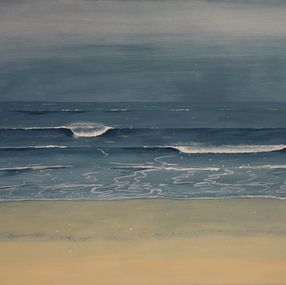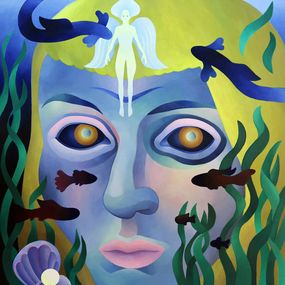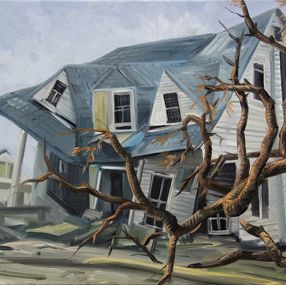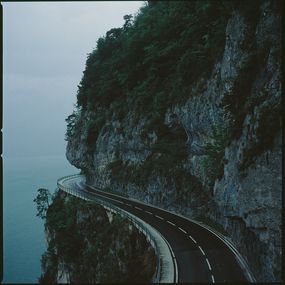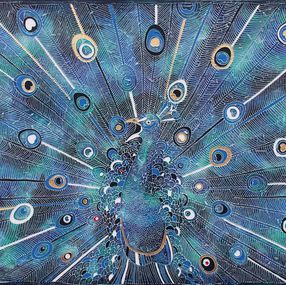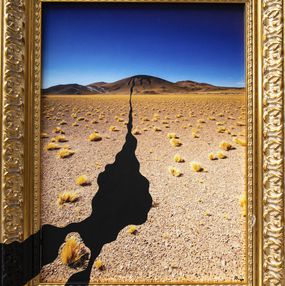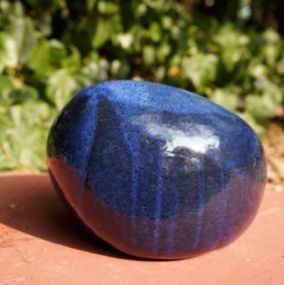
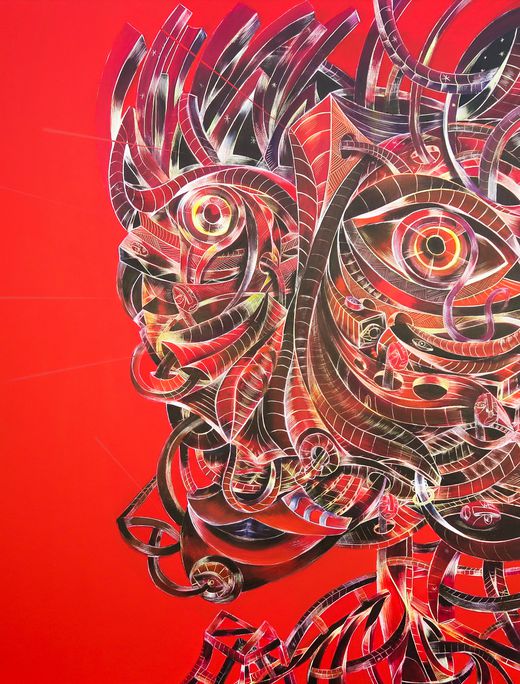
Biography
The career of the plastic artist Delwood, born in 1983, is atypical. Filled with a great desire for freedom and independence, he leaves school early in order to get out of a framework that does not suit him to quickly build a life in his image, far from the standards of children of the same age.
Delwood did not wait for someone to teach him imitations, he went to look for them and place them where they seemed right. Thus in third grade, revolted by a teacher persecuting a student and the tragic loss of her, he orchestrated his first large-scale urban intervention. He sees himself as the artist guiding operations while his sidekick is the gangster who assists him.
He chooses blue (a color that he considers to be that of hope and reminds him of his particular affection for the ocean) to repaint all of the exterior walls of the establishment which formed a U through the sculpture of the Virgin. This will earn him an indictment and a warning, a sort of probation. It is from this moment that he thinks of the urban, the street as a potential surface for creation.
A second event marks his life as a plastic artist. In 2001 he went to the Venice Biennale and visited the American pavilion. There he discovered Barry McGee's Street Market. A district is entirely reconstituted with piles of cars and where all the objects present are customized by different artists. He takes in full face the magnitude of this installation and with it the real meaning of Street Art. He then wishes to bring additional density to his work.
Painting and drawing are present with the artist from primary school. He took live model lessons and did watercolor workshops. (A practice of painting which can still be read today in his canvases, through diluted management of color, mastery of transparency).
In middle school and high school, he was enrolled at the Bayonne Art School, Delwood went there every Wednesday and on weekends and in 2001 joined the preparatory class for the entrance examination to the School of Fine Arts. In the end, he will not complete the process, considering himself ready to fully embark on plastic creation and considering that this feeling does not have to be validated by an Institution.
From 2003 to 2008 he drew a lot of food from the graffiti he saw in Spain in France, on blockhouses. He mainly produces lettering always on the verge of vandalism to titillate the authorities, to tickle the imposed limits.
His life is divided between the help he brings to the family business: a hotel located at the foot of the Bayonne train station, temporary assignments, mountain hiking, surfing and the plastic creation he exercises on different terrains. At that time, his workshop, located in his parents' hotel, was expanding more and more to reach an area of 130 m2. He navigates between the reception and his brushes and appreciates this place of passage where he meets many strangers who feed him.
He sold as soon as he entered preparatory school and had his first exhibition in 2007. In 2008, he began painting on canvas, unable to graffiti in the street following a second arrest.
The CV Crew and the NTM group particularly influenced him. It was not so much that he listened to rap, but appreciated the ability of NTM to appropriate the street or the metro for a proximity between musical creation and public.
He produces a lot and regularly presents his work until 2013.
Teaching comes little by little in his career and in his own way. He obtained the BAFA in 2010 and worked as an animator. He made two observations: on the one hand, the means in the field of animation are extremely thin and on the other hand what we offer to children is very limited. He wants to go further.
He works in schools and colleges in partnership with the Spacejunk - Bayonne gallery and with the EDF Works Council. This allows him to participate in the festival of urban cultures “Urban Vibrations” in Bordeaux. He collaborates with the Image department of the Biarritz media library and becomes an identified pedagogue, able to transmit from kindergarten to high school by using methods that he himself has developed from the culture of Street Art.
Today Delwood is a professor of applied arts. He found an alternative way of teaching allowing him to integrate the student's need for freedom and independence, just like what he experienced while creating in the street. He thus manages to set up large-scale projects without having to resort to discipline.
Delwood's playground and learning area is life, urban space, nature, which will soon earn him a license in visual arts obtained through a Validation of Acquired Experience.
Delwood claims an accessible, shared, communicative art, an art for all emerging from a form of elitism or academicism.
He is currently preparing a new series for a future exhibition.
ARTISTIC APPROACH
Delwood has a sensitivity and a very particular attention towards nature acquired by the freedom of movement and action which he granted himself at a very young age. Also his work is the witness of the hold of the Man on this nature and is declined on three supports.
The masks implanted in the urban space are a form that has existed since he painted. Coming from various influences: African mask, Moai sculptures (Easter Island), they function as a point of reference in his practice.
The mask is for him a universal reference because it is present in all civilizations and eras.
Emblem of the past, it comes to defend our future as the guardian of nature. It tries both to denounce the growing urbanization implemented by man and to contain it. Man has more respect for his past than for his future, using a primary emblem is to reintegrate this respect into our present to improve our future.
Mountains drawn on paper are the projection of our present impact on nature. Here again Delwood links past, present and future in the same production. It uses the codes of 19th century engraving using a fine-point pen using the hatching and cross-hatching technique. During this century, explorers went in search of mountain peaks, such as Henri Russel. Today we are no longer discovering, we are urbanizing these sites with the help of infrastructures that allow us to climb ever higher. These constructions are materialized in his drawings by colorful geometric shapes which are grafted onto the mountain. Delwood imagines our future: there is no more room below and we are forced to colonize the peaks. Ultimately the balance is reversed and urbanization wins the battle over nature: without it, the mountain crumbles.
The kinetic movement bulging on the walls is the translation of depth, of emptiness. An idea that came to him when he discovered works by Anish Kapoor. The kinetic movement is hypnotic, endless; just like the action of the Man who builds in an unreasonable way. To implant the mask within this movement is to reintroduce a landmark and thus signify this whirlwind in which we get lost.
Delwood completely covered derelict houses using this vortex. He shows us the void that will soon be filled again by yet another architectural program. Show the emptiness to raise awareness of the full or even the overflow.
The drawings on paper are carried out in a restraint necessary for the crosshair and the hatching which fill, while the kinetic movements are carried out in a letting go, a fall into the void. Delwood reintegrates the void in our lives by showing us the overflow of this galloping urbanization.
If the artist tackles heavy subjects, the colors he uses bring a form of lightness. He sees a playful aspect in the use of color. He tries to associate them as would instinctively a child because he considers that children naturally have the sense of colors.
Delwood alert in color.
Nationality
Artistic movements





